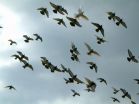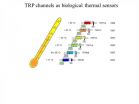(Press-News.org) Brood parasites are reproductive cheats that evolve ways of duping other birds into raising their young. Examples such as mimicry of host eggs, chicks and fledglings by brood parasitic eggs, chicks and fledglings are amongst the most iconic examples of animal deception in nature.
New research shows that adult brood parasitic female cuckoo finches have evolved plumage colours and patterns to mimic a harmless and abundant species, such as southern red bishops, to deceive possible host birds and reduce the risk of being attacked when approaching host nests to lay their eggs.
Researchers say this is the first time that "wolf in sheep's clothing" mimicry has been shown to exist in any adult bird.
While other brood parasites watch the movements of their host victims by hiding in nearby foliage, the openness of the African savannahs mean that mimicking a plentiful and nontoxic species might be the best way cuckoo finches have of sneaking up on host nests without raising the alarm.
However, the researchers found that the most common victim of the cuckoo finch, the tawny-flanked prinia, has evolved an awareness of the cuckoo finch's disguise and takes no chances - acting with equal aggression towards a female cuckoo finch and bishop alike.
Prinias attacked female cuckoo finches and female bishops equally, and increased the rate of egg rejection after seeing either a female cuckoo finch or female bishop near the nest. Egg rejection involves physically removing the parasitic egg from their nest, allowing them to salvage the majority of their reproductive effort.
At the study site in Zambia, the researchers found a consistently high rate of parasitism by cuckoos among the prinia population, with almost a fifth of all prinia eggs hatching as fledgling cuckoo finches. Cuckoo finches usually remove at least one egg on parasitism, and their hatchlings will out-compete all the host's young.
Researchers say these rates of parasitism might explain the willingness of prinias to attack anything that looks like a dangerous female cuckoo finch and reject more eggs when the risk of parasitism is high. But, the cost of this strategy can be high: during the researchers' experiments, some of the eggs rejected by prinia were their own, triggered by nothing more than a harmless bishop bird that resembles the mimetic cuckoo finch.
"Our findings suggest that female cuckoo finches are aggressive mimics of female bishops, and that prinia hosts have responded to this successful deception with generalised defences against cuckoo finches and harmless bishops alike. This suggests these prinias have decided that it's best to 'play it safe' when the risk of parasitism is high because they can't distinguish between the two species" said Dr William Feeney from Cambridge University's Department of Zoology, who led the research.
"While other brood-parasite species monitor host behaviour from concealed perches in nearby trees, cuckoo finches must seek host nests in open grasslands and savannahs. In such exposed circumstances, resembling an abundant and harmless model may allow female cuckoo finches to remain unnoticed when monitoring hosts nests at a medium range," he said.
The research is published today in the journal Proceedings of the Royal Society B.
To investigate the cuckoo finch's disguise, the research team conducted plumage and pattern analysis using cuckoo skins from the Natural History Museum in Tring. They compared plumage to the cuckoo finches closest evolutionary relatives (Vidua finches), as well as with the skins of similar-looking birds (bishops) that share the same habitat.
In both human and bird visual systems, they found that the plumage of a female cuckoo finch is far closer to the bishops and other species in the weaver family than to those of its closest relative, the Vidua finches.
The researchers also investigated the reaction of prinia breeding pairs to models of female cuckoo finches and bishop birds, as well as the males of both species.
While prinias had very little reaction to the males, the female cuckoo finch and the harmless female bishop bird both received similarly high levels of alarm calls and group attacks from the prinia, known as 'mobbing'.
The researchers then did a final experiment where they presented a male bishop, female bishop and female cuckoo finch and then placed a fake egg in their nest. They found that after seeing the harmful female cuckoo finch or harmless (but similar-looking) female bishop, they increased their rate off egg rejection compared to when they saw a male bishop near their nest.
Added Feeney: "This study is interesting as it's the first time anyone has quantitatively tested for 'wolf in sheep's clothing' mimicry in any adult bird, and also suggests that this type of mimicry is used by brood parasites to deceive hosts at all stages of their nesting cycle."
INFORMATION:
A young woman has become the first in the world to give birth to a healthy child after doctors restored her fertility by transplanting ovarian tissue that had been removed and frozen while she was a child.
A report of the case is published today in Human Reproduction [1], one of the world's leading reproductive medicine journals. While there have been reports of successful pregnancies after ovarian transplantation using tissue that had been removed from patients when they were adults, there have been none using tissue taken from girls before puberty and the ability of ...
Scientists at the University of Liverpool have shown that the most complete giant sauropod dinosaur, Dreadnoughtus, discovered by palaeontologists in South America in 2014, was not as large as previously thought.
Found in Patagonia, the huge fossil had almost all of the major bones intact, allowing scientists to confidently estimate its overall size - measuring in at 26 metres long.
Preserved in rock, it is thought that the animal was close to maturity but not fully grown when it died, and may have grown to be even larger. The long-necked, plant-eating dinosaur was ...
Having a hierarchical social structure with just a few well-connected leaders enables pigeon flocks to navigate more accurately on the wing, new research shows.
Hierarchical organisation also enables flocks to cope better with navigation errors made by individual birds.
Researchers from Oxford University and the Zoological Society of London created 'virtual flocks' of homing pigeons to test how different social networks affect the navigation performance of these groups. The team's simulations looked at everything from no networks (all connections between individuals ...
A single dose of the bivalent human papillomavirus (HPV) vaccine (Cervarix®, GlaxoSmithKline group of companies) may offer a similar level of protection against HPV-16/18 infections, which cause about 70% of cervical cancers, as the current two- and three-dose schedules, according to new research combining data from two large phase 3 trials published in The Lancet Oncology.
"Our findings question the number of HPV vaccine doses truly needed to protect the majority of women against cervical cancer, and suggest that a one-dose schedule should be further evaluated. ...
NEW YORK, June 9 -- The World Health Organization released its 2015 updated essential medicines list and for the first time included the progesterone contraceptive vaginal ring (CVR), a contraceptive safe and effective for lactating women in the postpartum period.
The progesterone CVR, developed by the Population Council, is an intravaginal ring that provides women who breastfeed at least four times a day with a contraceptive option as early as four weeks after giving birth. It can be used for up to a year for improved birth spacing.
'More than 220 million women in ...
UC Davis researchers have identified the molecular interactions that allow capsaicin to activate the body's primary receptor for sensing heat and pain, paving the way for the design of more selective and effective drugs to relieve pain. Their study appeared online June 8 in the journal Nature Chemical Biology.
Capsaicin is the ingredient that makes chili peppers spicy and hot. The same pathway in the body that responds to spicy food is also activated after injury or when the immune system mounts an inflammatory response to bacteria, viruses, or in the case of autoimmune ...
Our sun is a volatile star: explosions of light, energy and solar materials regularly dot its surface. Sometimes an eruption is so large it hurls magnetized material into space, sending out clouds that can pass by Earth's own magnetic fields, where the interactions can affect electronics on satellites, GPS communications or even utility grids on the ground.
The clouds can be large or small. They can be relatively slow or as fast as 3,000 miles per second, but only one component has a strong effect on how much a CME will arrange the magnetic fields in near-Earth space. ...
Researchers at the University of Pennsylvania have found a three to five percent reduction in the probability of criminal recidivism among a sample of juveniles arrested for felony drug offenses, some of whom were processed as adults due to their age at the time of their arrests.
In a study published in the Journal of Research in Crime and Delinquency, Charles Loeffler, an assistant professor of criminology in the School of Arts & Sciences and Ben Grunwald, a doctoral candidate in the criminology department, analyzed the effect of processing juveniles as adults using ...
For engine designers in the digital age, time is money. And that time is measured in computer cycles.
Researchers at the U.S. Department of Energy's Argonne National Laboratory are partnering with Convergent Science, Inc. (CSI), to speed up a key piece of modeling and simulation software to ensure those cycles are used as effectively as possible, reducing product development time and resulting in better engines and savings for consumers. The scale of the speed gains were recently demonstrated when researchers ran the largest engine simulation to date on more than 4,000 ...
Irvine, Calif., June 9 -- Brain inflammation caused by chronic nerve pain alters activity in regions that regulate mood and motivation, suggesting for the first time that a direct biophysical link exists between long-term pain and the depression, anxiety and substance abuse seen in more than half of these patients, UC Irvine and UCLA researchers report.
This breakthrough finding also points to new approaches for treating chronic pain, which is second only to bipolar disorder among illness-related causes of suicide. About a quarter of Americans suffer from chronic pain, ...




